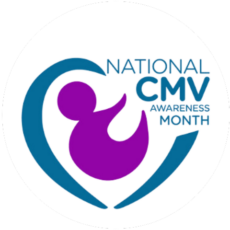
The Most Common Viral Cause of Birth Defects- CMV Awareness
What is CMV, do you ask?
CMV stands for cytomegalovirus (pronounced sy-toe-MEG-a-low-vy-rus), and it’s the most common virus no one has heard of! The reason is that although more than half of US adults have had CMV before the age of 40, the virus is usually asymptomatic, which is a big word that just means most, healthy people don’t have symptoms, or feel sick when they have it. If they do, they may just think they have the flu and have a fever, sore throat, swollen glands, or feel tired. CMV can be a big problem, though, if a pregnant woman has CMV while she’s pregnant.
If a woman has CMV during her pregnancy, the virus can infect her baby while inside the womb. When this happens, the baby is born with the virus, that is, they have a “congenital CMV infection”; this happens in 1 in 200 births! That’s a lot of babies each year in the United States. Good news: Just because a baby has a congenital CMV infection doesn’t mean they’ll be affected by it. Bad news: About 20% of babies with congenital CMV infection will have serious consequences. These children may develop permanent medical conditions and disabilities, such as deafness, blindness, cerebral palsy, mental and physical struggles, seizures, or on rare occasions, pass away. A congenitally infected child may have symptoms right away when they are born or sometimes, symptoms and problems can arise months or even years after birth.
Here are some important things to know:
- Congenital CMV is the most common viral cause of birth defects and developmental differences in the United States!
- Congenital CMV is the leading non-genetic (meaning not passed down from the parents to the baby) cause of hearing loss in children!
- CMV is found in body fluids, such as urine, saliva, blood, mucus, and tears. If a pregnant woman has direct contact with any of those and then touches her eyes, nose or mouth, she can become infected with the virus. She can also be infected through sexual contact.
- Toddlers often have CMV in their body fluids – especially if they are often around other little ones, so it’s super important for pregnant women to take behavioral precautions to prevent catching the virus.
Simple steps women can take during pregnancy to reduce their risk are:
- Washing hands often with soap and water for 15-20 seconds, especially after changing diapers, feeding a young child, wiping a young child’s nose or drool, and handling children’s toys.
- Try not to share food, drinks, or eating utensils with young children.
- Don’t put a child’s pacifier in their mouth.
- Do not share a toothbrush!
- Avoid contact with saliva when kissing a child – forehead kisses and lots of cuddles and snuggles are A-Okay!
- Clean toys, countertops, and other surfaces that come into contact with children’s body fluids.
There are lots of good resources if you want to learn more about CMV.
Visit the Utah Department of Health and Human Services CMV Education and Testing Program’s website at health.utah.gov/CMV or the National CMV Foundation’s website at nationalcmv.org.
Article by Stephanie Browning McVicar, Au.D., CCC-A, Doctor of Audiology Early Hearing Detection & Intervention (EHDI); Cytomegalovirus (CMV) Public Health Initiative; Children’s Hearing Aid Program (CHAP) Director






